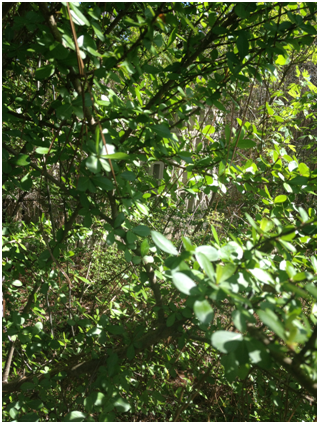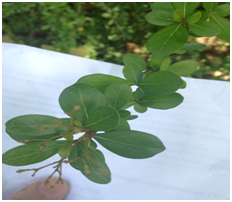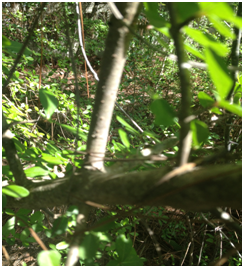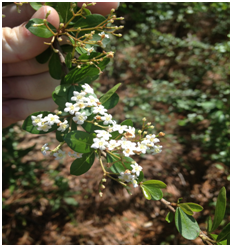Walter's Viburnum
Viburnum obovatum

(Photo by Jessica Gomez)
View the Location on Campus
Taxonomy (1)
Classification: Angiosperm, dicot
Family: Adoxaceae
Common name: Walter's Viburnum
General Information (1)
Region of Origin: Southeastern United States
USDA Plants Hardiness Zones: 6-9
Growth Habit: Shrub to small tree
- Size: 6-15 feet
- Deciduous/Evergreen: Evergreen
- Flowering: Spring
- Fruiting: Late summer
Diagnostic Characteristics
Leaves (1)
- Arrangement: Opposite
- Simple/Compound: Simple
- Shape: Obovate
- Other: 1-2 inches

(Photo by Jessica Gomez)
Stem/Bark (1)
- Color: Grey/silver
- Other: Younger twigs have reddish fuzz

(Photo by Jessica Gomez)
Flower (1)
- Color: Creamy white
- Size: 2-3 inches
- Inflorescence type: Cymes
- Other: Fragrant

(Photo by Jessica Gomez)
Fruit (1)
- Size: 1/4 inch
- Color: Red to black
Horticultural Information (1)
- Light: Full sun to partial shade
- pH: Acidic
- Maintenance: Easy to care for
- Landscape Uses: Hedge or topiary
References
1) Christman, S. (2006). Floridata. Viburnum obovatum. http://www.floridata.com/ref/V/vibu_obo.cfm
Prepared by Jessica Gomez as a course requirement for BIOL 3630/5630, Spring 2013
Edited by Jessica Bartek
Edited by Jessica Bartek
Department of Biology
-
Room 2035, 2nd Floor
Bailey Science Building -
Mailing Address
1500 N. Patterson St.
Valdosta, GA 31698 - Phone: 229.333.5759
- Fax: 229.245.6585
Monday - Thursday
8:00AM until 5:30PM
Friday
8:00AM until 3:00PM
Saturday - Sunday
Office Closed